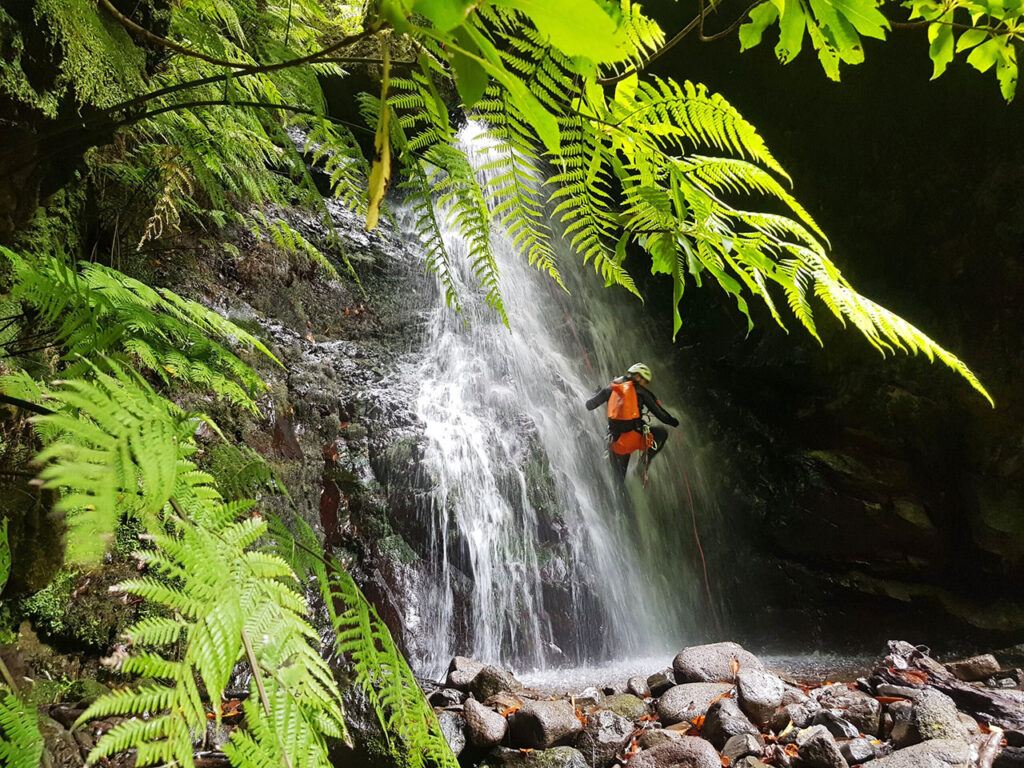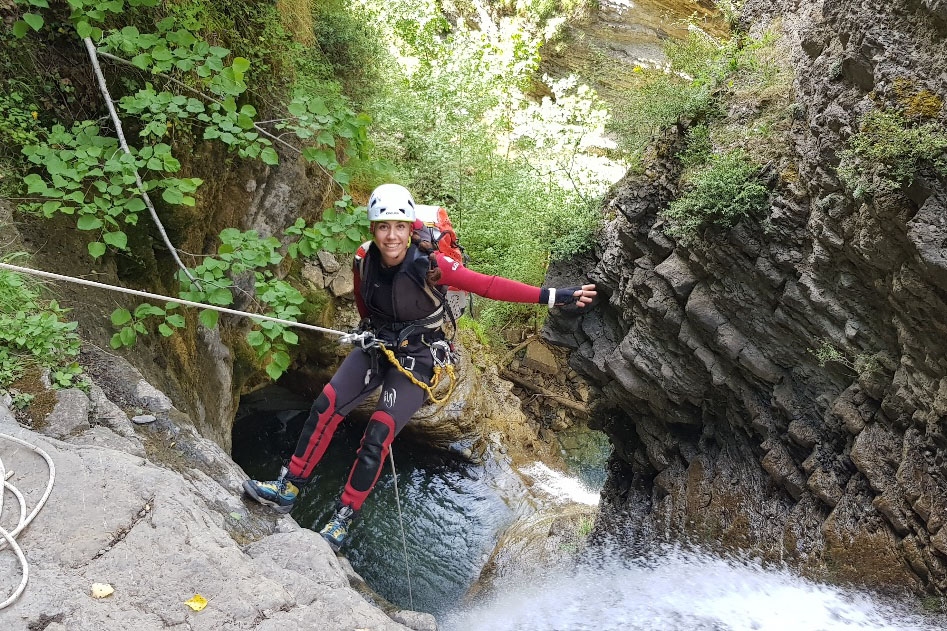Canyoning in Azores: Flores Island

Pyrenees and mountains 📩
Here 🔥Travelling to Flores Island is a unique experience to connect with the wildest and most remote nature of the Azores!
Canyoning on the island of Flores
Beautiful canyons with long slopes, overlooking or leading out to the ocean.

The landscape, dominated by green fields, shrubs, colossal plants and forests, contrasts with the electric blue of the Atlantic Ocean.
Ideal for trekking and canyoning enthusiasts, the island of Flores, has the most canyons of all the Azores. Specifically, 43 canyons.
The best time for canyoning in the Azores is from May/June to September. In Flores, the weather is quite changeable due to being the westernmost island of the Azores and its rugged terrain, being the most prone to rain, strong winds and weather changes.
In the summer months, temperatures range around 23ºC, while in winter, they can drop to 13ºC. It is, of course, very humid and foggy all the time.
Due to the rainfall and orography of the area, the ravines of Flores They have very vertical waterfalls, are steep, watery and with a lot of vegetation inside, and in many cases, they end up in the Atlantic Ocean, so it will be necessary for a boat to come and pick us up by sea.
A real adventure, going down these beautiful waterfalls that culminate in the sea and being able to see them from a boat as you leave them behind, admiring the beauty of the place as if it were a postcard.
Did you know that...
The Azores are also known as the European Hawaii. On some of its islands you will find waterfalls and bathing spots with hot springs in volcanic rock, especially on the island of Sao Miguel.
Three canyons not to be missed
As we said, of the 9 islands that make up the Azores, the island of Flores, with 43 open canyons, is the one with the most descents of all of them.. Many of them are divided into upper and lower sections, giving us the option of doing them in sections or as a whole, requiring more hours inside them or giving us the option of being able to escape in the event of heavy rain.
Among them all, we have decided on these three: Alquevins, Ribeira do Ferreiro and José Fraga. Three of the essential ones, but only a small sample of what this paradise for canyoners can offer you.
Alquevins Ravine

- Difficulty: medium-high
- Length: 1.1 km
- Difference in altitude: 235 m
- Number of abseils: 10
- Maximum rappel: 55m
The Alquevins canyon is one of the must-see canyons of Flores! With generous abseils and somewhat technical steps, as you reach the end, you will be won over by the views of the ocean.
Beautiful and generous waterfalls accompany you on this descent, but there remains the icing on the cake, its majestic 55-metre abseil straight into the sea.We will have to be picked up by a boat in order to reach the port with a fun trip by sea, while we observe the beauty of the place and the cliffs...!
To get there, we have 1 hour's walk along a comfortable but steeply ascending path in an environment with a lot of vegetation, where we will also cross the neighbouring Ilhéus Superior ravine.
It is a technical gully which, with a strong flow, can be somewhat compromised in its final cascade into the sea.
Ribeira do Ferreiro Ravine

- Difficulty: high
- Length: 0.7 km
- Slope: 240 m
- Number of abseils: 10
- Maximum rappel: 120 m
Another of the island's great canyons! If Alquevins already impressed us, Ferreiro will leave you open-mouthed! This is a very technical descent that combines everything, excitement and adventure until the end, spectacular views of the waterfall cirque and the sea, and in which large, vertical jumps will accompany us until the end of the descent. One of the most legendary descents on the island, not to be missed.
If you want to see the cirque of waterfalls where it is located, there is a short trekking route up to the viewpoint of Poço da Ribeira do Ferreiro which can be reached on foot in just 25 minutes. From here you will be able to see the grandiose verticality of this canyon. 120 metres and its neighbour Ribeira Grandeamong other waterfalls...
This descent requires a combination of vehicles. At the end of the descent, we will make a beautiful return hike from the last rappel to the starting car, through lush vegetation that sometimes almost closes the path, where we can see the Nãme and Cana Roca plants, typical in the Azores, some of which are colossal in size.
José Fraga Integral

- Difficulty: high
- Length: 1.7 km
- Slope: 600 m
- No. of abseils: 18
- Maximum rappel: 60 m
This is undoubtedly one of the most impressive canyons in Flores! An explosion of colour and adventure Epic waterfalls await you in this fun descent, such as the upper and lower José Fraga waterfalls.
A very complete canyon in which you will enjoy waterfalls of great beautyThe water is very short, both in terms of their length and the way in which the water falls into them, and in terms of their canyoned sections.
If we go down it after rainfall with an acceptable flow, it becomes a very aquatic adventure descent, with quite chained abseils, except for a fun section in which we will progress among large plants and lush vegetation that we will have to move aside to go down the riverbed.
A technical descent and undoubtedly one of the must-do's on the island, with marvellous views of the ocean.
It also requires a combination of cars, or if you prefer, you can do the lower section with just one car.
Two ruestros imprescindibles
A trip to the island of Flores is not complete without an excursion to get to know some of its natural wonders. If this is your first time in Flores, you can start with these two routes.
Miradouro das Lagoas Route

It is a Circular route of about 7 kilometres of medium level.In this area we can see different lakes that nature has created and an infinite number of waterfalls, especially after it rains.
The views of the lakes are truly spectacular and during the route we will be able to see different birds and flora endemic to the area, such as the Azores cedar or the sanguine.
It is advisable to take a mackintosh with you in case you get caught in a downpour on the route. On foggy days it will be quite difficult to see the lakes.
The path is waterlogged and muddy at times, so it will be necessary to wear hiking boots and to walk through the puddles on the paths.
Along the route we will find bird lookouts where we will be able to see blackbirds, kinglets, wrens and partridges, among others.
On days with good visibility, the islands of Terceira and São Jorge can be seen.
Fãja de Lopo Vaz

This round-trip route along the same path starts at the LopoVaz viewpoint. You start by going down some stone stairs which, after a 1.25 km descent, give access to a spectacular beach of very wild black sand, where some freshwater waterfalls end.
If you follow the path to the right through the rest of the houses of the Faja, between banana trees and other privately owned plantations, you will have a view of Ponta da Rocha Alta, another of the great waterfalls of Flores. At this point you will have to return along the same path.
Isle of Flowers: the essentials

The The Azores is an archipelago of 9 islands of volcanic origin.located 1,500 kilometres west of Lisbon, an autonomous region of Portugal.
In 2021, the population of the Azores was slightly more than 236,000 peopleHowever, in the island of Flores there was hardly any census 3,500 inhabitants.
The name "Flowers".in use since 1474 or 1475, is due to the abundance of yellow flowers, the "cubres" (Solidago sempervirens) that covered the coast of the island and whose seeds were possibly brought by migratory birds from the Florida peninsula in North America.
The archipelago sits on three of the world's major tectonic plates.The North American plate, the Eurasian plate and the African plate. The island of Flores next to the island of Corvothe two most westerly, are located on the North American plate.
The geomorphology de Flores is characterised by a central plateau with numerous peaks and lakeswith elevations between 500 and 600 metres. The highest point is Morro AltoThe coastline is rugged, with many caves and cliffs cut by streams. On the coast the terrain is steep, with many caves and cliffs cut by streams.

Caldeira Funda last erupted in 1200 BC and Caldeira Comprida in 950 BC. In many places, water is collected in volcanic calderas (or caldeiras in Portuguese), where lakes are formed. There are seven such lakes on the island. The Águas Quentes are small hot springs of boiling sulphurous water.
The island was discovered in 1452 by Diogo de Teive and his son Joaõ de Teive.
In 2009, Flores was chosen as one of the areas to be included in the list of UNESCO's World Network of Biosphere Reserves.





